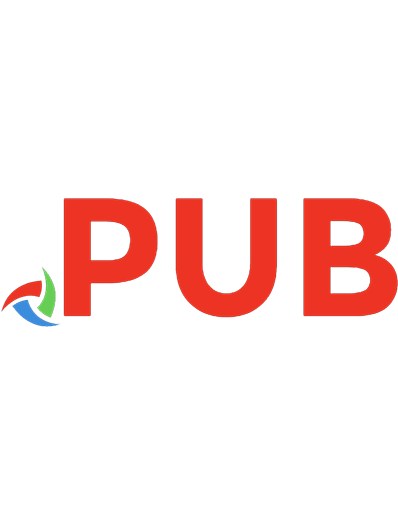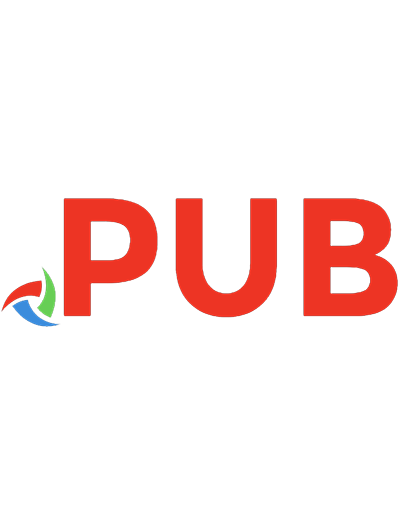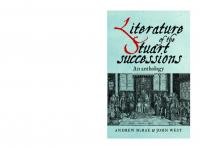An Anthology of London in Literature, 1558–1914 - ‘Flower of Cities All’ 9783030056094, 2018964113
370 30 1MB
English
Table of contents :
1 Period 1: London—Birth of a New Order (1558–1659)
INTRODUCTION
1.1 John Lyly: London the Ideal City
1.2 Donald Lupton: London Bridge
1.3 Robert Herrick Laments Leaving His Native London
1.4 Herrick’s Joyful Return to London
1.5 John Webster: The Decrepitude of Some London Buildings
1.6 John Donne: The Lively Streets of London
1.7 William Habington: In Praise of London in the Long Vacation
DRAMA AND THE THEATRE
1.8 Philip Stubbes: Puritan Objections to Stage Plays
1.9 Shakespeare: “On Your Imaginary Forces Work”
1.10 Shakespeare: The Best Actors Are but Shadows
THE PLAGUE
1.11 Thomas Nashe: “Adieu, Farewell, Earth’s Bliss”
1.12 Thomas Dekker: The Plague and Its Victims in 1603
THE COURT AND COURTIERS
1.13 Sir John Davies: “Our Glorious English Court’s Divine Image”
1.14 Edmund Spenser: Another View of Love at Court
1.15 Anon.: A Courtier
1.16 Thomas Dekker: “How a Young Gallant Should Behave Himself in an Ordinary”
WHO SHOULD ’SCAPE WHIPPING?
1.17 John Earle: A Shopkeeper
1.18 Thomas Middleton: A Goldsmith Gulled
1.19 Barnabe Rich: Vanity Fair
1.20 Thomas Harman: An Abraham Man
1.21 Robert Greene: Beware of Pickpockets
1.22 Middleton: Roaring Girls
1.23 Ben Jonson: Pickpockets at Bartholomew Fair
1.24 John Earle: A Prison
1.25 Donald Lupton: Bedlam
1.26 Dekker and Middleton: Entertainment Provided by the Inmates of Bedlam
THE COMING OF THE COMMONWEALTH
1.27 Andrew Marvell: The Execution of Charles I
1.28 John Evelyn: “The Funeral Sermon of Preaching”
1.29 Evelyn: Persecution of Royalist Churchgoers
References
2 Period 2: London in the Enlightenment (1660–1780)
INTRODUCTION
2.1 Celia Fiennes: Some Topographical Features of London
2.2 Daniel Defoe: London Surging in Size
THE RESTORATION
2.3 John Evelyn: Charles II’s Triumphal Entry into London
2.4 Evelyn: Bodies of Cromwell and Others Exhumed
2.5 Evelyn: Gambling and Debauchery at the Court of Charles II
2.6 Evelyn: James II’s Ill-Timed Feast for the Venetian Ambassadors
THE GREAT PLAGUE
2.7 Samuel Pepys Describes the Plague
2.8 Daniel Defoe’s Imaginative Reconstruction of the Great Plague
THE GREAT FIRE
2.9 John Dryden: London on Fire
2.10 Pepys’ Buried Treasures
2.11 Defoe: London Before and After the Fire
INSTITUTIONS
2.12 John Evelyn: Some Unusual Proceedings of the Royal Society
2.13 Ned Ward: The Rebuilding of St Paul’s Cathedral
2.14 Joseph Addison: The Royal Exchange
2.15 Ned Ward: Crowds at the Entrance to the Royal Exchange
2.16 Defoe: Westminster Abbey
ALL THAT LIFE CAN AFFORD
2.17 Samuel Johnson in Praise of London
2.18 John Gay: The Labyrinthine Streets of London
2.19 Gay on Pall Mall
2.20 Jonathan Swift: “A Description of a City Shower”
2.21 Tobias Smollett: Ranelagh and Vauxhall Gardens
2.22 Hannah More: The Bluestocking Circle
2.23 Ned Ward: Pork Sellers at Bartholomew Fair
2.24 Benjamin Franklin: “Work, the Curse of the Drinking Classes”
A WALK ON THE WILD SIDE
2.25 John Gay: Perils of London by Night
2.26 James Smith: Sex-Workers in the Strand
2.27 Daniel Defoe on Shoplifting
2.28 Defoe: Newgate Prison
2.29 Samuel Richardson: An Execution at Tyburn
2.30 Samuel Johnson: The Crime of Poverty
2.31 Thomas Holcoft: The Gordon Riots
References
3 Period 3: London—New Riches, New Squalor (1781–1870)
INTRODUCTION
AN OPENING MISCELLANY
3.1 Charlotte Bronte: London as Life and Freedom
3.2 Mary Robinson: “London’s Summer Morning”
3.3 Charles Dickens: A London ‘Pea-Souper’
3.4 William Cobbett: The Great Wen
3.5 William Wordsworth: Alienation and Anonymity
3.6 Alfred, Lord Tennyson: The Noise of Life Begins Again
3.7 William Blake: “Marks of Woe”
3.8 Charles Dickens: A Sunday in London
3.9 William Makepeace Thackeray: “Going to See a Man Hanged.”
DELIGHTS AND BEAUTIES
3.10 Thomas Hood: Let’s All Go Down the Strand
3.11 John Ruskin Recalls a Childhood Paradise at Herne Hill
3.12 William Wordsworth: “Composed Upon Westminster Bridge, September 3, 1802”
3.13 Matthew Arnold, “Lines Written in Kensington Gardens”
3.14 George Borrow on Cheapside
3.15 Frederick Locker-Lampson, “St. James’s Street,” 1867
3.16 Charles Dickens: Going Up the River
3.17 Nathaniel Hawthorne: A London Suburb
INSTITUTIONS
3.18 William Blake: St Paul’s Cathedral on Holy Thursday
3.19 Thomas De Quincey: Tourists Must Pay to See the Sights of St Paul’s Cathedral
3.20 Charles Dickens: The Building of a Railway
3.21 Henry Mayhew and George Cruikshank: The Great Exhibition and the Crystal Palace
3.22 John Ruskin: The Crystal Palace
3.23 Thomas de Quincey: The Theatre Royal, Drury Lane, Destroyed
3.24 Benjamin Disraeli: A View of Politicians
MIDDLE CLASS LIFE
3.25 Anthony Trollope: Publicans and Sinners
3.26 Alfred, Lord Tennyson: “Ode Sung at the Opening of the International Exhibition” (1862)
3.27 Charles Dickens: A London Hackney-Coach
3.28 Charles Lamb: “The Old Benchers of the Inner Temple”
3.29 Wilkie Collins: A Child’s Sunday in London
3.30 Elizabeth Gaskell: Haste to the Wedding
3.31 Charles Dickens: Dinner in Harley Street
3.32 Charles Dickens: Bran-New People
3.33 William Thackeray: Wars and Rumours of Wars
3.34 Robert Smith Surtees, Sponge in the City
3.35 Herman Melville: The Temple
3.36 William Makepeace Thackeray: “Great City Snobs”
3.37 Elizabeth Barrett Browning: A Writing Woman
WORKING-CLASS LIFE
3.38 Leigh Hunt: A London Waiter
3.39 Henry Mayhew: Covent Garden Market
3.40 Charles Dickens: Bleeding Heart Yard
3.41 Charles Kingsley: The Making of a Chartist
3.42 William Morris: “Prologue: The Wanderers”
3.43 Henry Mayhew: “The Narrative of a Gay Woman”
3.44 Thomas De Quincey: “Preliminary Confessions”
3.45 Dante Gabriel Rossetti: “Jenny”
3.46 Christina Rossetti, ‘In an Artist’s Studio’
3.47 Thomas Hardy: “The Ruined Maid”
References
4 Period 4: London—Capital of Empire, 1871–1914
INTRODUCTION
AN OPENING MISCELLANY
4.1 Thomas Hardy, “Snow in the Suburbs”
4.2 Henry James, a Saturday Evening Stroll
4.3 Lionel Johnson: “By the Statue of King Charles at Charing Cross”
4.4 George Moore: A Train Journey
DELIGHTS AND BEAUTIES
4.5 Emily Constance Cook: The Respectable Grime of Ages
4.6 Henry James: The Appeal of the Great City
4.7 Oscar Wilde, “Impression du Matin”
4.8 H. G. Wells: An Evening in Hyde Park
4.9 Robert Bridges, “London Snow”
THE AESTHETIC MOVEMENT
4.10 Oscar Wilde: “London Models”
4.11 Vernon Lee: The Mazes of Aesthetic London
4.12 George Moore: Bohemian Life in Mayfair
4.13 George Gissing: A Struggling Writer
INSTITUTIONS
4.14 William S. Gilbert: The House of Peers
4.15 Anthony Trollope: The House of Commons
4.16 George Gissing: The Crystal Palace Park
4.17 Arnold Bennett: A London Bank
4.18 C. W. Murphy: “I Live in Trafalgar Square”
THE THAMES
4.19 Henry James: A Steamer Down the Thames
4.20 Joseph Conrad: Sunset on the Thames
MIDDLE CLASS LIFE
4.21 George Eliot: A House by the Thames
4.22 Margaret Oliphant: The Painter and the Philistine
4.23 George Gissing: The Women’s Movement
4.24 Mary Augusta Ward: A Politician and His Wife
4.25 Lady St Helier: Politics and the Music-Hall
4.26 George and Weedon Grossmith: Nobody Is Invited to a Ball
WORKING-CLASS LIFE
4.27 George Gissing: Supreme Ugliness in the Caledonian Road
4.28 Joseph Conrad: Bombs and Pornography
4.29 Israel Zangwill: A Child of the Ghetto
4.30 D. H. Lawrence: Outcasts of Waterloo Bridge
4.31 Amy Levy: “Ballade of an Omnibus”
4.32 Arthur Morrison: A Slum
4.33 Baroness Emmuska Orczy: Death on the Tube
4.34 Virginia Woolf: Leaving London
AFTER LONDON
4.35 Richard Jefferies: Drowned London
EPILOGUE: TOWN VERSUS COUNTRY
4.36 Beatrix Potter: Town Mouse and Country Mouse
References
Further Reading
Part 1: Historical Contexts
Part 2: Literary Contexts
Index

![An Anthology of London in Literature, 1558-1914: 'Flower of Cities All' [1 ed.]
9783030056087, 9783030056094, 2018964113](https://dokumen.pub/img/200x200/an-anthology-of-london-in-literature-1558-1914-flower-of-cities-all-1nbsped-9783030056087-9783030056094-2018964113.jpg)


![An Anthology of London in Literature, 1558-1914: 'Flower of Cities All' [1st ed.]
978-3-030-05608-7, 978-3-030-05609-4](https://dokumen.pub/img/200x200/an-anthology-of-london-in-literature-1558-1914-flower-of-cities-all-1st-ed-978-3-030-05608-7-978-3-030-05609-4.jpg)





